Badger Meter 2014FNML ORION Fixed Network Metal Lid User Manual Exhibit D Users Manual per 2 1033 b3
Badger Meter Inc ORION Fixed Network Metal Lid Exhibit D Users Manual per 2 1033 b3
Exhibit D Users Manual per 2 1033 b3
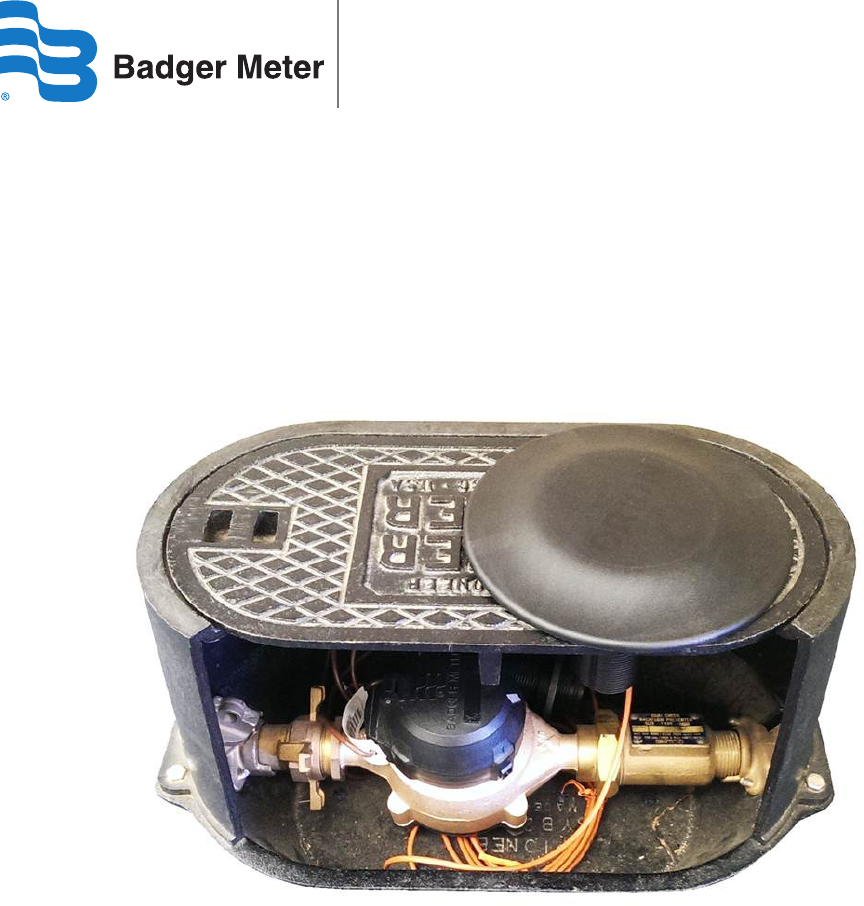
ORION®
Fixed Network - Metal Lid Endpoint
ORI-UM-00955-EN (May 2014 FCC draft) Installation Manual
draft

ORION® Fixed Network – Metal Lid Endpoint
Page ii May 2014
draft

Installation Manual
CONTENTS
OVERVIEW . . . . . . . . . . . . . . . . . . . . . . . . . . . . . . . . . . . . . . . . . . . . . . . . . . . . . . . . . . . .5
PRODUCT UNPACKING AND INSPECTION . . . . . . . . . . . . . . . . . . . . . . . . . . . . . . . . . . . . . . .5
LICENSE REQUIREMENTS . . . . . . . . . . . . . . . . . . . . . . . . . . . . . . . . . . . . . . . . . . . . . . . . . .5
IDENTIFICATION . . . . . . . . . . . . . . . . . . . . . . . . . . . . . . . . . . . . . . . . . . . . . . . . . . . . . . . .6
ENDPOINT INSTALLATION . . . . . . . . . . . . . . . . . . . . . . . . . . . . . . . . . . . . . . . . . . . . . . . . . .7
Installation Kit . . . . . . . . . . . . . . . . . . . . . . . . . . . . . . . . . . . . . . . . . . . . . . . . . . . . . . . .7
ORION Fixed Network Endpoints . . . . . . . . . . . . . . . . . . . . . . . . . . . . . . . . . . . . . . . . . . . .8
Encoder Connectivity,Wiring and Read Resolution . . . . . . . . . . . . . . . . . . . . . . . . . . . . . . . . .8
Activating the Endpoint . . . . . . . . . . . . . . . . . . . . . . . . . . . . . . . . . . . . . . . . . . . . . . . . . .9
WIRING AN ORION ENDPOINT TO AN ENCODER . . . . . . . . . . . . . . . . . . . . . . . . . . . . . . . . . . 10
Splicing Guidelines . . . . . . . . . . . . . . . . . . . . . . . . . . . . . . . . . . . . . . . . . . . . . . . . . . . . 10
Using Gel Caps to Connect an Encoder . . . . . . . . . . . . . . . . . . . . . . . . . . . . . . . . . . . . . . . 11
Testing Wire Connections . . . . . . . . . . . . . . . . . . . . . . . . . . . . . . . . . . . . . . . . . . . . . . . .12
Page iii May 2014
draft

ORION® Fixed Network – Metal Lid Endpoint
Page iv May 2014
draft

Installation Manual
OVERVIEW
This manual contains installation instructions for the ORION® Fixed Network - Metal Lid water endpoint.
• Installation of ORION endpoints must comply with all applicable federal, state and local rules, regulations and codes.
• Failure to read and follow these instructions can lead to misapplication or misuse of this product, resulting in
personal injury and damage to equipment.
• Proper performance and reliability of ORION endpoints depend upon installation in accordance with
these instructions.
PRODUCT UNPACKING AND INSPECTION
Upon receipt of the product, perform the following unpacking and inspection procedures.
OTE:N If damage to the shipping container is evident upon receipt, request the carrier to be present when the product
is unpacked.
Carefully open the shipping package, follow any instructions that may be marked on the exterior. Remove all cushioning
material surrounding the product and carefully lift the product from the package.
Retain the package and all packing material for possible use in reshipment or storage.
Visually inspect the product and applicable accessories for any physical damage such as scratches, loose or broken parts or
any other sign of damage that may have occurred during shipment.
OTE:N If damage is found, request an inspection by the carrier’s agent within 48 hours of delivery and file a claim with the
carrier. A claim for equipment damage in transit is the sole responsibility of the purchaser.
Carefully remove the pre-wired ORION endpoint and encoder assembly or ORION endpoint from the shipping carton and
inspect for damage. Retain the contents of the installation kit for use in mounting the endpoint in the field.
LICENSE REQUIREMENTS
ORION endpoints comply with Part 15 of FCC Rules. Operation of this device is subject to the following conditions: (1) This
device may not cause harmful interference, and (2) this device must accept any interference received, including interference
that may cause undesired operation of the device.
In accordance with FCC Regulations, “Code of Federal Regulations” Title 47, Part 2, Subpart J, Section 1091, transmitters
pass the requirements pertaining to radiation exposure. However, to avoid public exposure in excess of limits for general
population (uncontrolled exposure), a 20 centimeter distance between the transmitter and the body of the user must be
maintained during testing.
No FCC license is required by a utility to operate an ORION meter reading system.
This device complies with Industry Canada license-exempt RSS standard(s). Operation is subject to the following two
conditions: (1) this device may not cause interference, and (2) this device must accept any interference, including interference
that may cause undesired operation of the device. Le présent appareil est conforme aux CNR d'Industrie Canada applicables
aux appareils radio exempts de licence. L'exploitation est autorisée aux deux conditions suivantes : (1) l'appareil ne doit pas
produire de brouillage, et (2) l'utilisateur de l'appareil doit accepter tout brouillage radioélectrique subi, même si le brouillage
est susceptible d'en compromettre le fonctionnement.
MPORTANTI
Transportation: The Federal Aviation Administration prohibits operating endpoints and receivers on all commercial
aircraft. The ORION endpoint is considered an operating transmitter and cannot be shipped by air.
Page 5 May 2014
draft
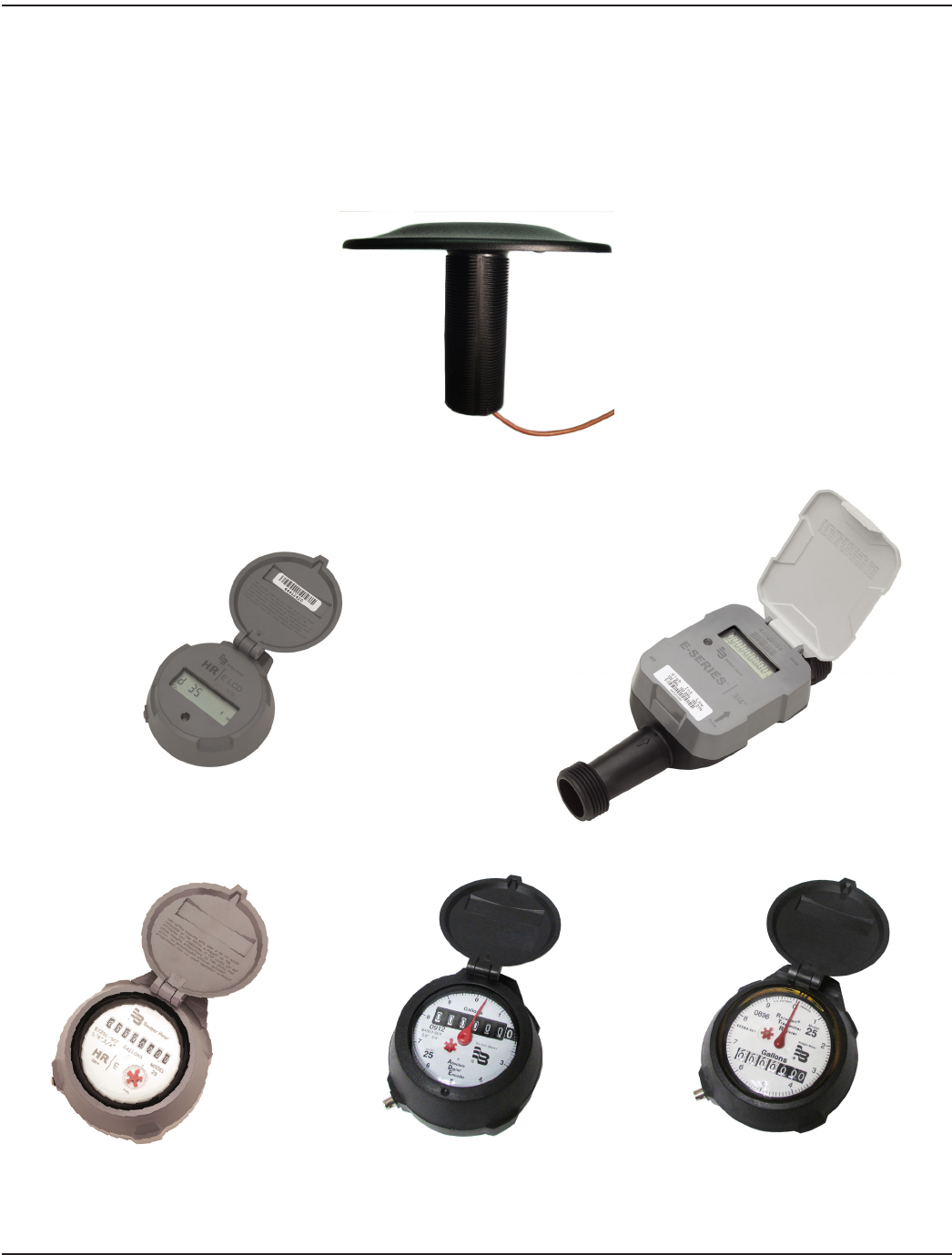
ORION® Fixed Network – Metal Lid Endpoint
IDENTIFICATION
The ORION Fixed Network - Metal Lid endpoint is a three-wire metering endpoint device that requires connection to an
encoder to complete the assembly. The endpoint and compatible Badger Meter encoders are shown below.
Each ORION endpoint has a unique numeric serial number on the tag attached to the wire harness and etched on the side of
the endpoint housing. Each Badger Meter encoder is identified on the face of the register with an assembly number, unit of
measure and meter model.
ORION Fixed Network - Metal Lid Endpoint
High Resolution LCD Encoder (HR-E LCD) E-Series® Ultrasonic Meter with
High Resolution LCD Encoder
High Resolution 8-Dial Encoder (HR-E) Absolute Digital Encoder (ADE®) Recordall® Transmitter Register (RTR®)
Figure 1: Endpoint and encoders
Page 6 May 2014
draft
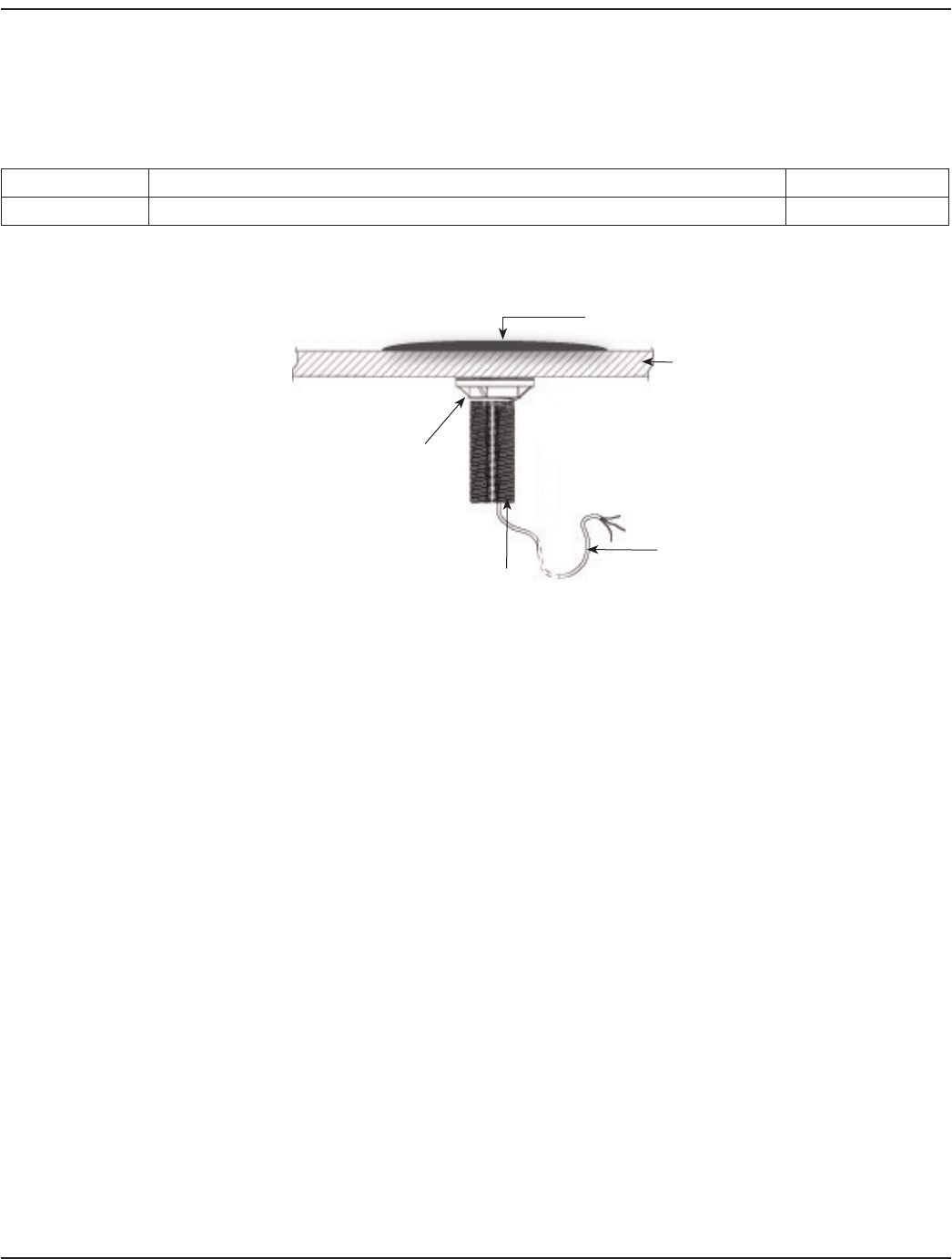
Installation Manual
ENDPOINT INSTALLATION
ORION Metal Lid endpoints can be configured with a 308 or Nicor inline connector for installation.
Installation Kit
TYPE DESCRIPTION Kit Part Number
PIT Metal Pit Lid Endpoint Installation Kit 64394-009
The Metal Pit Lid Installation Kit (PN: 64394-009) is designed for use with the Metal Lid endpoint, and has a 1-7/8 inch
standard hole diameter. The pit lid maximum thickness is 4 inches.
Figure 2: Metal Lid endpoint through pit lid
To install the endpoint, follow these steps and refer to Figure 2.
OTE:N If the lock nut is preattached to the endpoint tube, unscrew and remove it before inserting the endpoint and
cable into the pit lid opening.
1. Insert the endpoint tube with the cable through the pit lid opening, so the endpoint cap is resting on the pit lid.
2. Feed the endpoint cable through the lock nut.
3. Screw the lock nut onto the endpoint tube—all the way up—until it meets the bottom of the pit lid.
4. Tighten the nut against the bottom of the pit lid until secure.
5. Connect the encoder to the endpoint using the proper method – 308 connector, Nicor connector or eld splice – to
complete the installation.
OTE:N The Metal Lid endpoint is not intended for non-metal, under-the-lid or remote installation.
OTE:N Refer to the ORION Water Endpoint Parts List, available at www.badgermeter.com for individual endpoint kit
components.
Endpoint cap with antenna
Lock nut
Endpoint tube
4“ maximum pit lid
thickness
Endpoint cable
Page 7 May 2014
draft

ORION® Fixed Network – Metal Lid Endpoint
ORION FIXED NETWORK METAL LID ENDPOINTS
This section contains information regarding identification, encoder compatibility and wiring, and activation for ORION Fixed
Network endpoints. ORION Fixed Network endpoints have a serial number range of 30000000 to 599999999.
Encoder Connectivity,Wiring and Read Resolution
ORION Metal Lid endpoints are available for connectivity to Badger Meter encoders and E-Series Ultrasonic meters as well as a
number of competitive encoders as shown in chart below.
Endpoints are shipped from the factory pre-programmed and are available in a three-wire configuration for connection to the
encoders noted. Endpoint installation kit instructions begin at "Endpoint Installation" on page 7.
The ORION Metal Lid endpoint is a three-wire metering endpoint device that requires connection to an encoder to complete
the assembly. All three wires must be connected to complete an installation. The connection can be made to either existing
wires from the encoder or directly to the terminal screws of the encoder, depending on the application and manufacturer.
Follow the manufacturer’s installation kit instructions provided with the gel splice or field splice kit you are using.
OTE:N Due to the customized, factory wire configurations of the Hersey Translator, the terminal posts may not match
the ORION endpoint wire colors. Please contact Hersey for the terminal post wiring schematic of your encoders to
determine how the posts correspond to ORION endpoint wires.
ORION endpoint wires: Red = Power/Clock; Black = Ground; Green = Data
Endpoint
Label Encoder Connectivity
Endpoint Wire Colors
Red Black Green Reading Resolution
ELCD or ENC Badger Meter HR-E LCD or HR-E encoders, or
E-Series Ultrasonic Meter with High Res output
Encoder Wire/Termination Colors
Red Black Green Up to eight (8) most
signicant digits
ADE or ENC Badger Meter ADE or E-Series Ultrasonic Meter with
ADE output Red Black Green Up to six (6) most
signicant digits
RTR Badger Meter RTR or E-Series Ultrasonic Meter with
RTR output Red Black Green Up to seven (7) most
signicant digits
ADE or ENC Elster/AMCo ScanCoder or Invision* Green Black Red Up to eight (8) most
signicant digits
C700D Elster/AMCo C700 Digital* Red Black
Not used –
cut green wire
ush with outer
sheath
Up to seven (7) most
signicant digits
ADE or ENC Metron Hawkeye* Red Black Green Up to eight (8) most
signicant digits
ADE or ENC Neptune ProRead, E-coder or ARB-V* Black Green Red Up to eight (8) most
signicant digits
ADE or ENC Sensus ECR II or ICE* Red Black Green Up to eight (8) most
signicant digits
* ORION Metal Lid ADE or ENC endpoints are compatible with the encoders noted above with a manufacture date of 2000 or
newer as long as the encoder is programmed into the three-wire output mode for AMR/AMI and has three wires connected to
it. Encoder registers that are currently in two-wire mode of operation require programming by the Utility, including registers
that support auto two- or three-wire detection systems that do not automatically switch to three-wire mode of operation
once a compatible endpoint is connected for ORION connectivity.
OTE:N For those endpoint connections that are not equipped with inline connectors, see "Wiring an ORION Endpoint to an
Encoder" on page 10.
Page 8 May 2014
draft

Installation Manual
Activating the Endpoint
ORION Metal Lid endpoints are shipped in an inactive, non-transmitting state known as “Pause” mode.
OTE:N Endpoints shipped via air are shipped in “Stop” (hard sleep) mode and must be activated via infrared (IR)
communication using an ORION handheld or mobile reading system and the ORION Endpoint Utility software.
RTR
When an RTR is mounted on the water meter, and the ORION Metal Lid endpoint is connected to the RTR for the first time,
the endpoint will register a tamper, which must be cleared before the ORION system is ready for operation. Use the ORION
handheld or mobile meter reading equipment to program and set the endpoint odometer value.
HR-E or ADE
When an HR-E or ADE is mounted on the water meter, and the ORION endpoint connected to the encoder is securely installed,
the ORION system is ready for operation. The endpoint will turn on with water usage. It requires up to one fifteen minute
reading interval where consumption changes the electronic reading. For example, with an ORION endpoint connected to
an eight-dial HR-E or six-dial ADE, the encoder must detect consumption of 10 gallons over a fifteen minute reading period
before the endpoint will begin broadcasting data. Once the endpoint begins broadcasting, it will update hourly based on the
encoder odometer reading. No specific wire testing or endpoint programming is required.
OTE:N Reading an ORION endpoint with the ORION handheld or mobile meter reading equipment immediately after
installation verifies proper operation and reading performance.
High Resolution ELCD Encoder or E-Series Ultrasonic Meter
When an HR-ELCD encoder is mounted on the water meter, or when an E-Series Ultrasonic meter is installed, and the ORION
endpoint connected to the encoder or E-Series Ultrasonic meter is securely installed, the ORION system is ready for operation.
The endpoint will turn on with water usage. When using consumption, the endpoint requires one fifteen minute interval
where the least significant digit on the encoder changes before it will begin broadcasting data. Once the endpoint has begun
broadcasting, it will update hourly based on the HR-E LCD encoder or High Resolution E-Series Ultrasonic meter odometer
reading. No specific wire testing or endpoint programming is required.
OTE:N Reading an ORION endpoint with the ORION handheld or mobile meter reading equipment immediately after
installation verifies proper operation and reading performance.
Conrming an Installation
Before leaving the installation site, the installer can use an ORION handheld or mobile reading system to confirm the endpoint
wiring has been done correctly and that the endpoint is broadcasting RF data for reading. See the appropriate handheld or
mobile reading system user manuals for more information.
Page 9 May 2014
draft
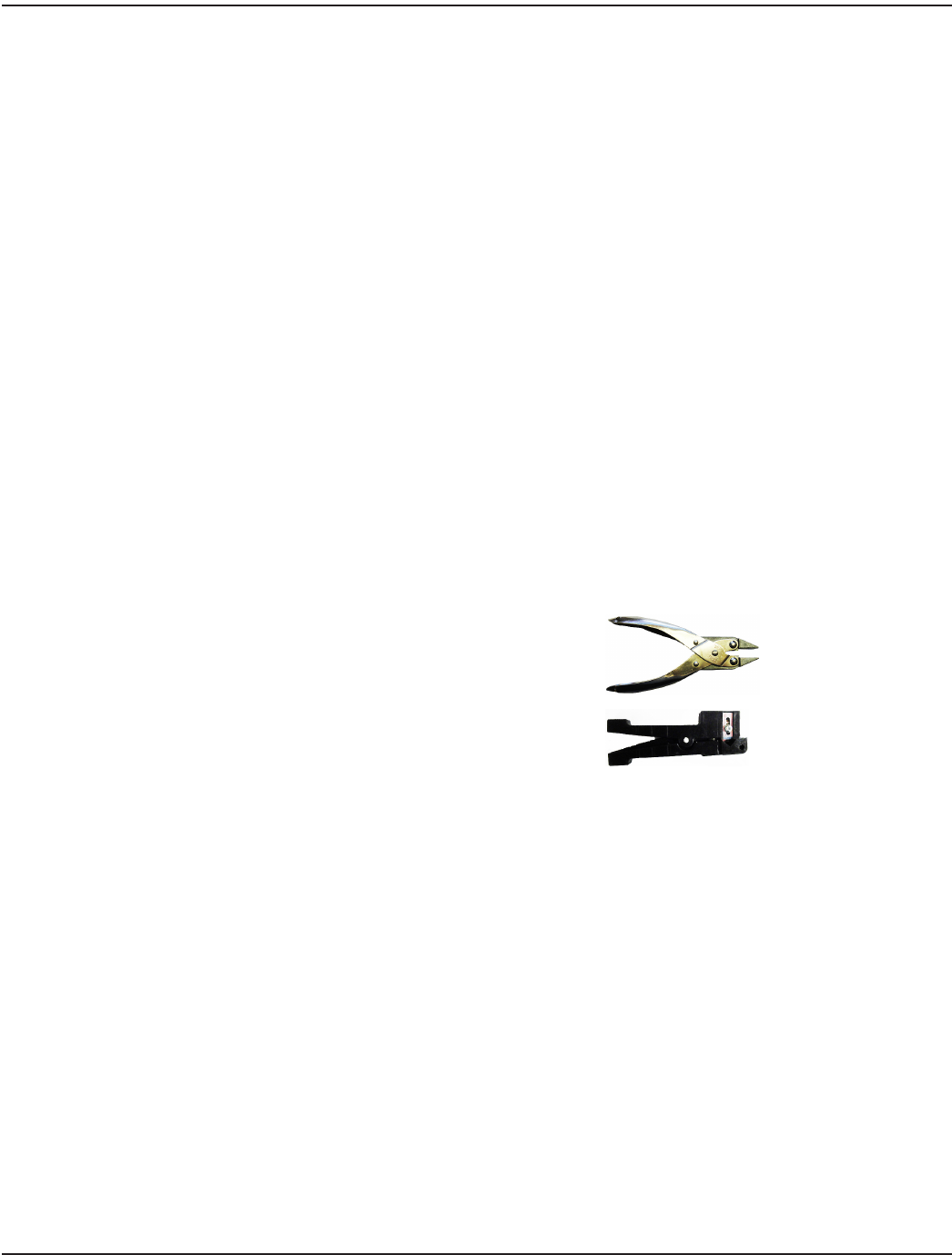
ORION® Fixed Network – Metal Lid Endpoint
WIRING AN ORION ENDPOINT TO AN ENCODER
An ORION endpoint is a three-wire metering endpoint device that requires connection to an encoder to complete the
assembly. All three wires must be connected to complete an installation.
The ORION endpoint connection can be made to either existing wires from the encoder or directly to the terminal screws of
the encoder, depending on the application and manufacturer. If making a connection to existing wires, use the installation
kit provided. Refer to the charts starting on page 8 for the endpoint type and determine which wires need to be
connected to complete an installation.
Splicing Guidelines
For those connections that are not factory wired or equipped with inline connectors, follow these guidelines when splicing is
required, either for installation or to fix a repair after a tamper.
OTE:N ORION endpoints are shipped factory pre-wired to a Badger Meter encoder and require no splicing. It is only
necessary to connect the endpoint connector to the encoder connector, mount the encoder to the meter and
tighten the TORX® seal screw to complete installation.
• For pit environments, splice connections require a field splice kit (62084-001), which can be ordered separately. Refer
to the instructions found in the document, Field Splice Kit for Badger Meter AMR/AMI Products, which is available at
www.badgermeter.com.
• For all installations, excess wire should be coiled and cable tied to avoid any damage.
• Required splicing tools are shown here.
Splice Tools (Customer Supplied) Badger Meter Part Number
• Gel Splice Crimping Tool 59983-001
• Coax Wire Stripper 59989-001
• Wire Cutter n/a
Page 10 May 2014
draft
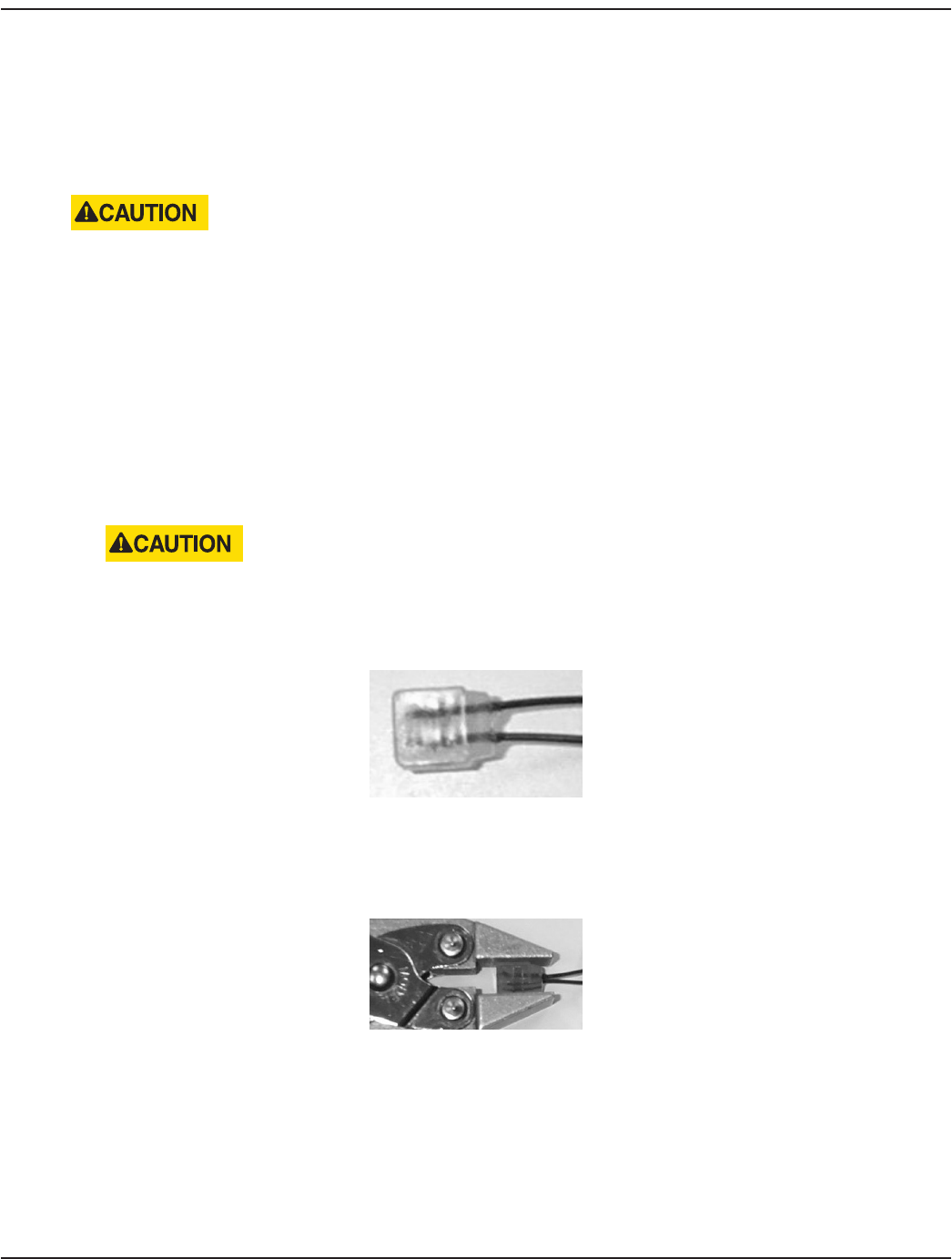
Installation Manual
Using Gel Caps to Connect an Encoder
Follow these steps when using Badger Meter supplied gel caps.
1. To connect an encoder with existing wires to an ORION endpoint, strip approximately 1-1/2 inches of outer insulation
sheath from the encoder and endpoint cables using a coax stripping tool. We recommend using the Badger Meter
Coax Stripper (59989-001).
USE CAUTION WHEN REMOVING THE OUTER SHEATH SO THAT THE INNER SIGNAL WIRE INSULATION IS NOT
NICKED OR DAMAGED.
2. Unwind the outer foil shield from the endpoint cable and cut it o even with the outer sheath using wire
cutting pliers.
3. Connect the ORION endpoint to an approved encoder. Verify the endpoint serial number prior to completing the
wiring setup.
• Connect the encoder cable wires to the ORION endpoint wires using the insulation gel caps provided in the
installation kit. Refer to the charts starting on page 8 for the endpoint type and determine which wires need
to be connected to complete an installation.
OTE:N The terminal posts and wire colors may not match.
DO NOT STRIP ANY INSULATION FROM THE ENDS OF THE WIRES BEFORE YOU PUSH THEM INTO THE GEL
CAP.
• Insert the wires from each cable end as far as possible into the gel cap. See Figure 27.
Figure 3: Wires in gel cap
• Using a crimping tool such as the Badger Meter Gel Splice Crimping Tool (59983-001), place the gel cap with the
wires into the jaws of the crimping tool.
Figure 4: Gel cap in crimping tool
• Crimp the gel cap by squeezing the crimping tool handles until the gel cap is completely compressed. The crimp
tool is designed to prevent applying too much pressure to the gel cap. Apply pressure for three seconds.
Page 11 May 2014
draft
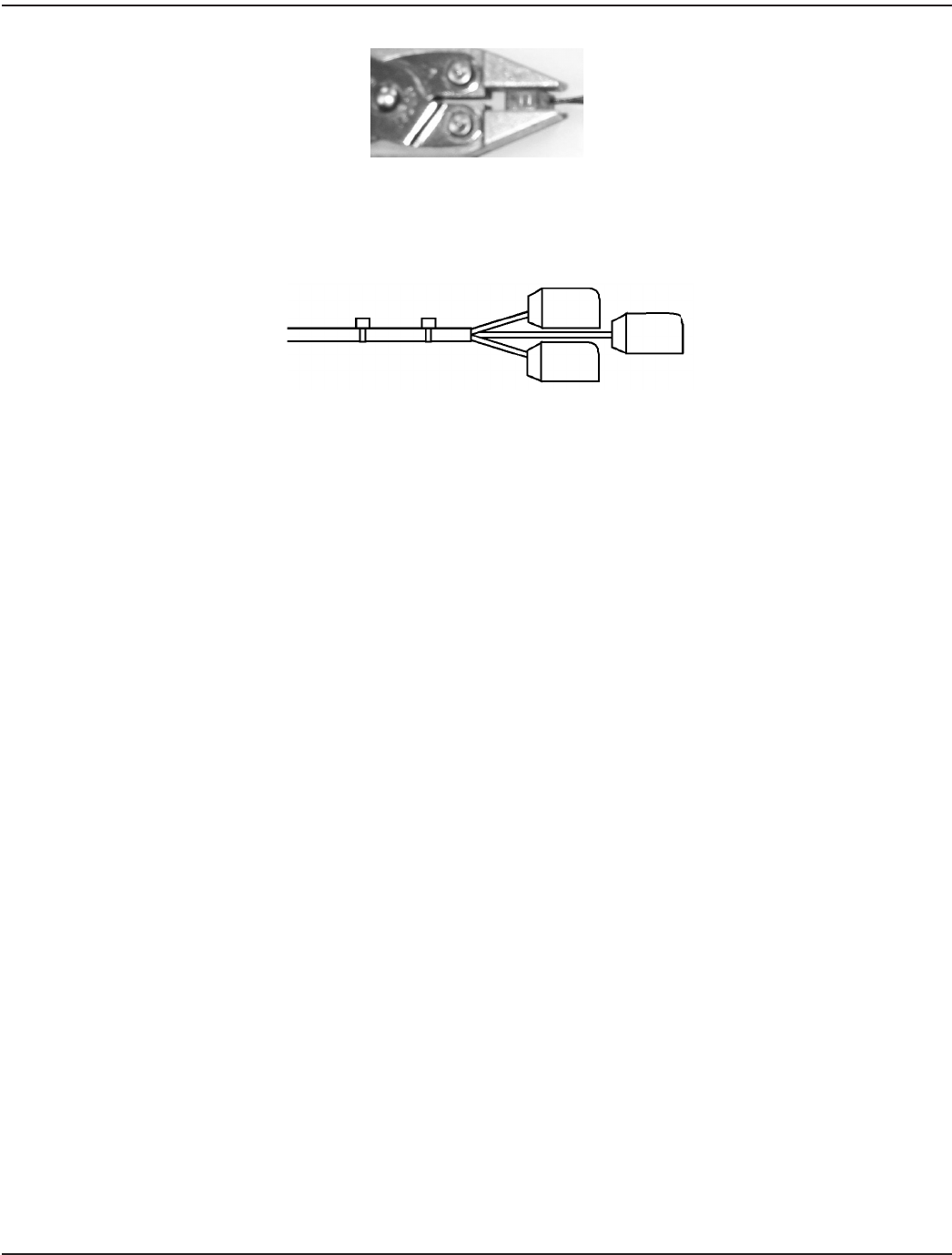
ORION® Fixed Network – Metal Lid Endpoint
Figure 5: Compress the gel cap
• Repeat the crimping procedure for the remaining gel caps and wires.
4. Attach the two plastic cable ties and tighten securely for strain relief. Snip o the excess cable tie with the wire cutter.
Figure 6: Wire tie attachment locations
5. To complete the pit installations, use an appropriate secondary eld splice kit. If using the Badger Meter Field Splice
Kit, refer to the Field Splice Kit Application Data Sheet provided with the kit.
Testing Wire Connections
It is recommended that you test all wiring connections to confirm connectivity and to verify the ORION endpoint reading
and the encoder reading are the same. The connections can be tested using the Quick Read function with either an
ORION handheld or mobile data collector. See the appropriate software manual, available at www.badgermeter.com, for
more information.
Page 12 May 2014
draft

Installation Manual
Page 13 May 2014
draft

ORION® Fixed Network – Metal Lid Endpoint
INTENTIONAL BLANK PAGE
Page 14 May 2014
draft

Installation Manual
INTENTIONAL BLANK PAGE
Page 15 May 2014
draft

Making Water Visible®
www.badgermeter.com
ADE, Making Water Visible, ORION and RTR are registered trademarks of Badger Meter, Inc. Other trademarks appearing in this document are the property of their respective
entities. Due to continuous research, product improvements and enhancements, Badger Meter reserves the right to change product or system specications without notice, except
to the extent an outstanding contractual obligation exists. © 2014 Badger Meter, Inc. All rights reserved.
The Americas | Badger Meter | 4545 West Brown Deer Rd | PO Box 245036 | Milwaukee, WI 53224-9536 | 800-876-3837 | 414-355-0400
México | Badger Meter de las Americas, S.A. de C.V. | Pedro Luis Ogazón N°32 | Esq. Angelina N°24 | Colonia Guadalupe Inn | CP 01050 | México, DF | México | +52-55-5662-0882
Europe, Middle East and Africa | Badger Meter Europa GmbH | Nurtinger Str 76 | 72639 Neuen | Germany | +49-7025-9208-0
Europe, Middle East Branch Office | Badger Meter Europe | PO Box 341442 | Dubai Silicon Oasis, Head Quarter Building, Wing C, Office #C209 | Dubai / UAE | +971-4-371 2503
Czech Republic | Badger Meter Czech Republic s.r.o. | Maříkova 2082/26 | 621 00 Brno, Czech Republic | +420-5-41420411
Slovakia | Badger Meter Slovakia s.r.o. | Racianska 109/B | 831 02 Bratislava, Slovakia | +421-2-44 63 83 01
Asia Pacic | Badger Meter | 80 Marine Parade Rd | 21-04 Parkway Parade | Singapore 449269 | +65-63464836
China | Badger Meter | 7-1202 | 99 Hangzhong Road | Minhang District | Shanghai | China 201101 | +86-21-5763 5412
draft